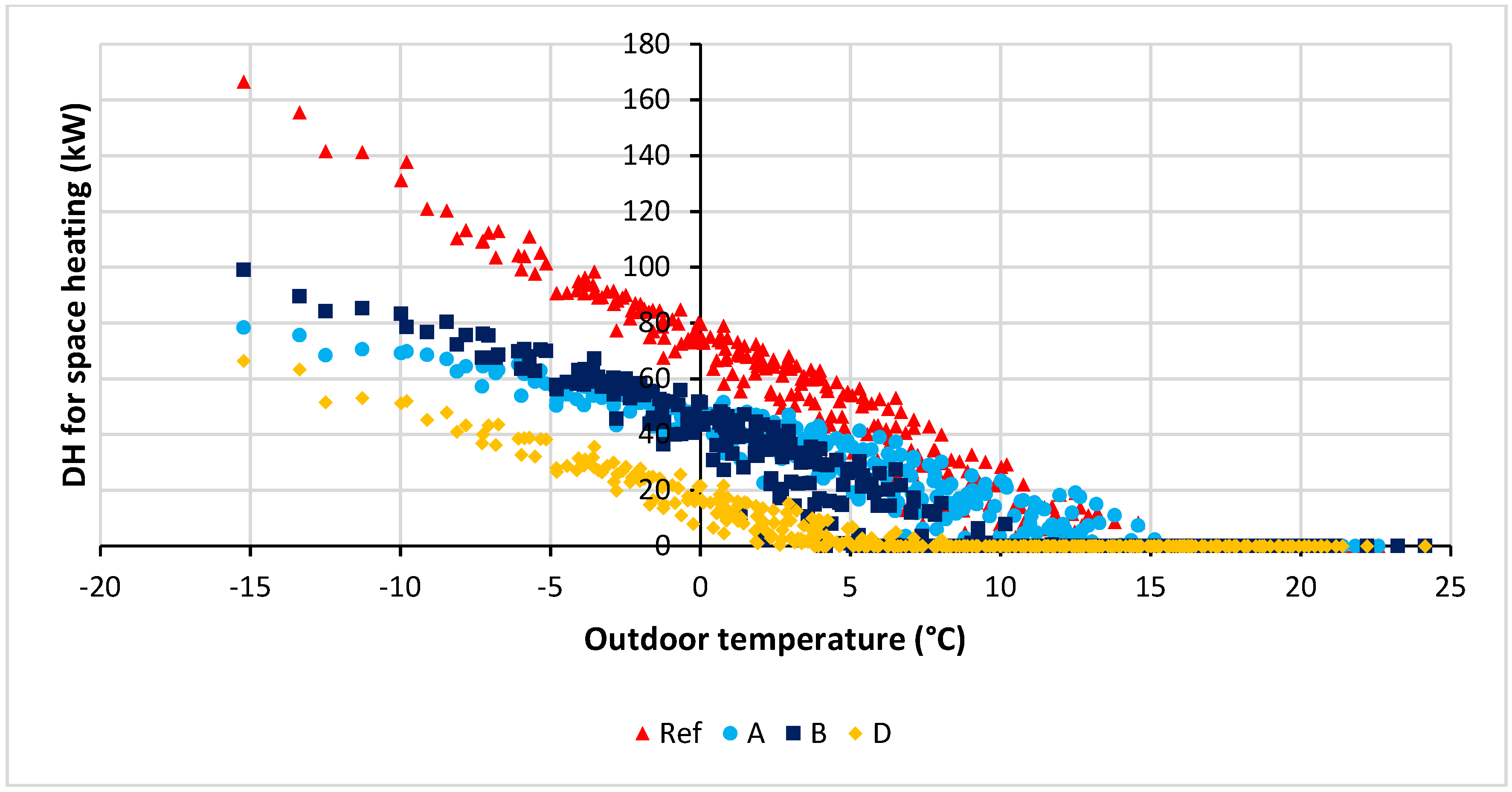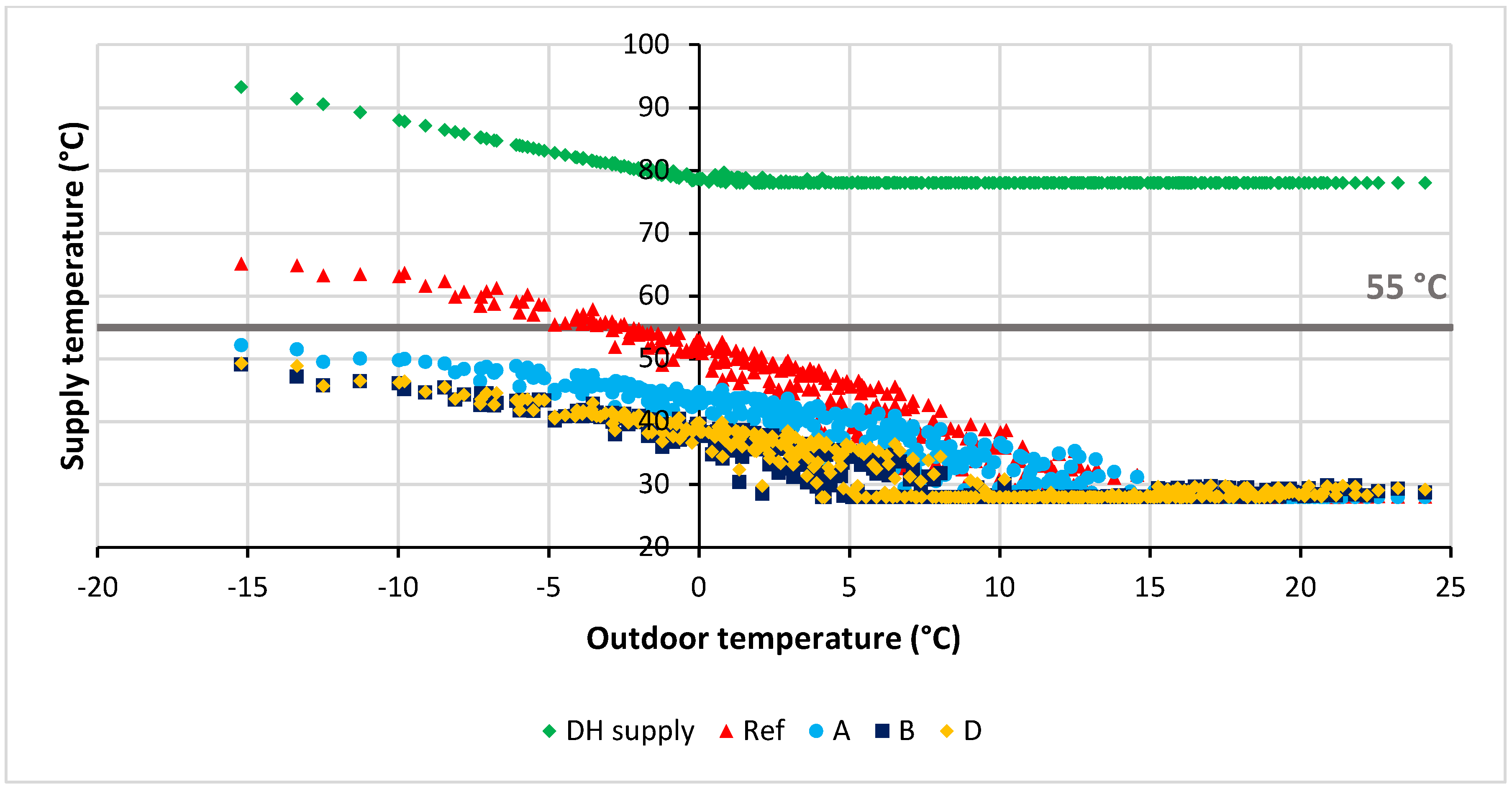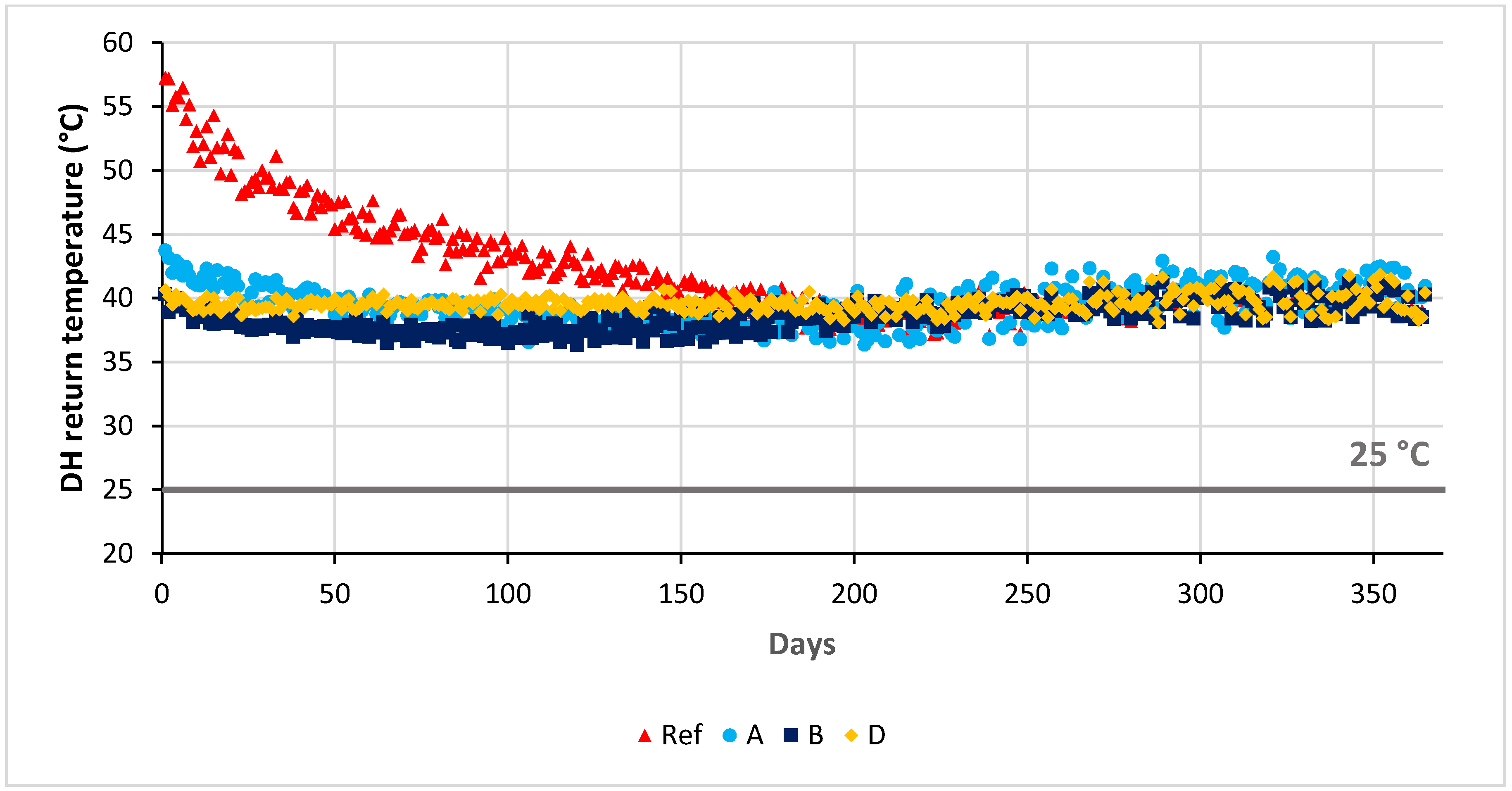Impact of Domestic Hot Water Systems on District Heating Temperatures
Abstract
:1. Introduction
2. Materials and Methods
2.1. Case Study Building
2.2. The Energy Refurbishment Packages
2.3. Performance Gap and Limitations
3. Results
4. Discussion
5. Conclusions
Author Contributions
Funding
Acknowledgments
Conflicts of Interest
References
- Energimyndigheten Swedish Energy Agency. Energiläget 2019. Available online: https://www.energimyndigheten.se/statistik/energilaget/ (accessed on 9 December 2019).
- Energimyndigheten Swedish Energy Agency. Summary of Energy Statistics for Dwellings and Non-Residental Premises for 2016. Available online: https://www.energimyndigheten.se/globalassets/statistik/bostader/energistatistik-for-smahus-flerbostadshus-och-lokaler-2016.pdf (accessed on 9 December 2019).
- European Union. Energy Efficiency Directive. Available online: https://ec.europa.eu/energy/en/topics/energy-efficiency/energy-efficiency-directive (accessed on 27 January 2019).
- Lidberg, T.; Olofsson, T.; Ödlund, L. System impact of energy efficient building refurbishment within a district heated region. Energy 2016, 106, 45–53. [Google Scholar] [CrossRef]
- Gustafsson, M.; Gustafsson, M.S.; Myhren, J.A.; Bales, C.; Holmberg, S. Techno-economic analysis of energy renovation measures for a district heated multi-family house. Appl. Energy 2016, 177, 108–116. [Google Scholar] [CrossRef] [Green Version]
- Lundström, L.; Wallin, F. Heat demand profiles of energy conservation measures in buildings and their impact on a district heating system. Appl. Energy 2016, 161, 290–299. [Google Scholar] [CrossRef] [Green Version]
- Dodoo, A.; Gustavsson, L.; Tettey, U.Y. Final energy savings and cost-effectiveness of deep energy renovation of a multi-storey residential building. Energy 2017, 135, 563–576. [Google Scholar] [CrossRef]
- Lund, H.; Werner, S.; Wiltshire, R.; Svendsen, S.; Thorsen, J.E.; Hvelplund, F.; Mathiesen, B.V. 4th Generation District Heating (4GDH). Integrating smart thermal grids into future sustainable energy systems. Energy 2014, 68, 1–11. [Google Scholar] [CrossRef]
- Lund, H.; Østergaard, P.A.; Chang, M.; Werner, S.; Svendsen, S.; Sorknæs, P.; Bojesen, C. The status of 4th generation district heating: Research and results. Energy 2018, 164, 147–159. [Google Scholar] [CrossRef]
- Schmidt, D.; Kallert, A.; Blesl, M.; Svendsen, S.; Li, H.; Nord, N.; Sipilä, K. Low temperature district heating for future energy systems. Energy Procedia 2017, 116, 26–38. [Google Scholar] [CrossRef]
- Sernhed, K.; Lygnerud, K.; Werner, S. Synthesis of recent Swedish district heating research. Energy 2018, 151, 126–132. [Google Scholar] [CrossRef]
- Hesaraki, A.; Ploskic, A.; Holmberg, S. Integrating low-temperature heating systems into energy efficient buildings. Energy Procedia 2015, 78, 3043–3048. [Google Scholar] [CrossRef]
- Wang, Q.; Ploskic, A.; Song, X.; Holmberg, S. Ventilation heat recovery jointed low-temperature heating in retrofitting—An investigation of energy conservation, environmental impacts and indoor air quality in Swedish multifamily houses. Energy Build. 2016, 121, 250–264. [Google Scholar] [CrossRef]
- Connolly, D.; Lund, H.; Mathiesen, B.V.; Werner, S.; Möller, B.; Persson, U.; Boermansd, T.; Triere, D.; Østergaardb, P.A.; Nielsen, S. Heat Roadmap Europe: Combining district heating with heat savings to decarbonise the EU energy system. Energy Policy 2014, 65, 475–489. [Google Scholar] [CrossRef]
- Lund, R.; Østergaard, D.S.; Yang, X.; Mathiesen, B.V. Comparison of low-temperature district heating concepts in a long-term energy system perspective. Int. J. Sustain. Energy Plan. Manag. 2017, 12, 5–18. [Google Scholar]
- Østergaard, D.S.; Svendsen, S. Space heating with ultra-low-temperature district heating—A case study of four single-family houses from the 1980s. Energy Procedia 2017, 116, 226–235. [Google Scholar] [CrossRef]
- Yang, X.; Svendsen, S. Ultra-low temperature district heating system with central heat pump and local boosters for low-heat-density area: Analyses on a real case in Denmark. Energy 2018, 159, 243–251. [Google Scholar] [CrossRef]
- Harrestrup, M.; Svendsen, S. Changes in heat load profile of typical Danish multi-storey buildings when energy-renovated and supplied with low-temperature district heating. Int. J. Sustain. Energy 2015, 34, 232–247. [Google Scholar] [CrossRef]
- Liu, L.; Moshfegh, B.; Akander, J.; Cehlin, M. Comprehensive investigation on energy retrofits in eleven multi-family buildings in Sweden. Energy Build. 2014, 84, 704–715. [Google Scholar] [CrossRef]
- Hong, S.H.; Oreszczyn, T.; Ridley, I. The impact of energy efficient refurbishment on the space heating fuel consumption in English dwellings. Energy Build. 2006, 38, 1171–1181. [Google Scholar] [CrossRef]
- Østergaard, D.S.; Svendsen, S. Are typical radiators over-dimensioned? An analysis of radiator dimensions in 1645 Danish houses. Energy Build. 2018, 178, 206–215. [Google Scholar] [CrossRef]
- Østergaard, D.S.; Svendsen, S. Replacing critical radiators to increase the potential to use low-temperature district heating e A case study of 4 Danish single-family houses from the 1930s. Energy 2016, 110, 75–84. [Google Scholar] [CrossRef] [Green Version]
- Vesterberg, J.; Andersson, S. Achieved energy and climate goals in project Ålidhem: An evaluation of a refurbishment of 21 Swedish multifamily buildings. Energy Procedia 2017, 132, 51–56. [Google Scholar] [CrossRef]
- Gill, Z.M.; Tierney, M.J.; Pegg, I.M.; Allan, N. Low-energy dwellings: The contribution of behaviours to actual performance. Build. Res. Inf. 2010, 38, 491–508. [Google Scholar] [CrossRef]
- Boverket. Swedish National Board of Housing Building and Planning. Boverkets Byggregler, BBR, 1st ed.; Boverket: Karlskrona, Sweden, 2018. [Google Scholar]
- Dansk Standard. DS 439 Code of Practice for Domestic Water Supply Installations; 2009; Dansk Standard: Charlottenlund, Denmark, 2019. [Google Scholar]
- ECDC. Legionnaires’ Disease Annual Epidemiological Report for 2017; ECDC: Stockholm, Sweden, 2019. [Google Scholar]
- Yang, X.; Li, H.; Svendsen, S. Alternative solutions for inhibiting Legionella in domestic hot water systems based on low-temperature district heating. Chart. Inst. Build. Serv. Eng. 2016, 37, 468–478. [Google Scholar] [CrossRef]
- Yang, X.; Li, H.; Svendsen, S. Decentralized substations for low-temperature district heating with no Legionella risk, and low return temperatures. Energy 2016, 110, 65–74. [Google Scholar] [CrossRef] [Green Version]
- Averfalk, H.; Werner, S. Novel low temperature heat distribution technology. Energy 2018, 145, 526–539. [Google Scholar] [CrossRef]
- Cholewa, T.; Siuta-Olcha, A.; Anasiewicz, R. On the possibilities to increase energy efficiency of domestic hot water preparation systems in existing buildings—Long term field research. J. Clean. Prod. 2019, 217, 194–203. [Google Scholar] [CrossRef]
- Bøhm, B. Production and distribution of domestic hot water in selected Danish apartment buildings and institutions. Analysis of consumption, energy efficiency and the significance for energy design requirements of buildings. Energy Convers. Manag. 2013, 67, 152–159. [Google Scholar] [CrossRef]
- Klein, S.A.; Beckman, A.; Mitchell, W.; Duffie, A. TRNSYS 17—A TRansient SYstems Simulation Program; Solar Energy Laboratory, University of Wisconsin: Madison, WI, USA, 2011. [Google Scholar]
- Lidberg, T.; Gustafsson, M.; Myhren, J.A.; Olofsson, T.; Ödlund, L. Environmental impact of energy refurbishment of buildings within different district heating systems. Appl. Energy 2017, 227, 231–238. [Google Scholar] [CrossRef]
- Hall, T.; Vidén, S. The Million Homes Programme: A review of the great Swedish planning project. Plan. Perspect. 2005, 20, 301–328. [Google Scholar] [CrossRef]
- Dalarna University. Research Project: Varsam Energieffektiv Renovering Tjärna Ängar. 2019. Available online: https://www.du.se/en/research/research-projects2/?code=HDA2015-00017 (accessed on 9 December 2019).
- Dodoo, A.; Gustavsson, L.; Sathre, R. Primary energy implications of ventilation heat recovery in residential buildings. Energy Build. 2011, 43, 1566–1572. [Google Scholar] [CrossRef]
- Pumps, T.H. Thermia—Thermia Mega XL. 2019. Available online: https://www.thermia.se/varmepumpar/fastighetsvarmepumpar/mega-fastighetsvarmepump/ (accessed on 9 December 2019).
- Myhren, J.A.; Holmberg, S. Design considerations with ventilation-radiators: Comparisons to traditional two-panel radiators. Energy Build. 2009, 41, 92–100. [Google Scholar] [CrossRef]
- Hesaraki, A.; Bourdakis, E.; Ploskic, A.; Holmberg, S. Experimental study of energy performance in low-temperature hydronic heating systems. Energy Build. 2015, 109, 108–114. [Google Scholar] [CrossRef]
- Danielski, I. Large variations in specific final energy use in Swedish apartment buildings: Causes and solutions. Energy Build. 2012, 49, 276–285. [Google Scholar] [CrossRef]
- De Wilde, P. The gap between predicted and measured energy performance of buildings: A framework for investigation. Autom. Constr. 2014, 41, 40–49. [Google Scholar] [CrossRef]
- Allard, I.; Olofsson, T.; Nair, G. Energy evaluation of residential buildings: Performance gap analysis incorporating uncertainties in the evaluation methods. Build. Simul. 2018, 11, 725–737. [Google Scholar] [CrossRef]









| ERP | Heating | DHW | Ventilation | Radiators | U-Value, W/(m2 K) | DHW Demand, L/(p∙day), 45 °C | ||
|---|---|---|---|---|---|---|---|---|
| Walls | Roof | Windows | ||||||
| Ref. | DH | DH | Exhaust | Panel | 0.34 | 0.24 | 3.15 | 38 |
| A | DH | DH | MVHR | Panel | 0.23 | 0.11 | 1.52 | 28 |
| B | DH | DH | Exhaust | Ventilation | 0.23 | 0.11 | 1.52 | 28 |
| C | DH + EAHP | DH | Exhaust | Ventilation | 0.23 | 0.11 | 1.52 | 28 |
| D | DH + EAHP | DH + EAHP | Exhaust | Ventilation | 0.23 | 0.11 | 1.52 | 28 |
| District Heating Use | Ref. | A | B | C | D |
|---|---|---|---|---|---|
| For space heating (kWh/m2 y) | 84 (69%) | 31 (55%) | 53 (68%) | 23 (48%) | 24 (52%) |
| For DHW (kWh/y) | 38 (31%) | 26 (45%) | 26 (32%) | 26 (52%) | 21 (48%) |
© 2019 by the authors. Licensee MDPI, Basel, Switzerland. This article is an open access article distributed under the terms and conditions of the Creative Commons Attribution (CC BY) license (http://creativecommons.org/licenses/by/4.0/).
Share and Cite
Lidberg, T.; Olofsson, T.; Ödlund, L. Impact of Domestic Hot Water Systems on District Heating Temperatures. Energies 2019, 12, 4694. https://doi.org/10.3390/en12244694
Lidberg T, Olofsson T, Ödlund L. Impact of Domestic Hot Water Systems on District Heating Temperatures. Energies. 2019; 12(24):4694. https://doi.org/10.3390/en12244694
Chicago/Turabian StyleLidberg, Tina, Thomas Olofsson, and Louise Ödlund. 2019. "Impact of Domestic Hot Water Systems on District Heating Temperatures" Energies 12, no. 24: 4694. https://doi.org/10.3390/en12244694






